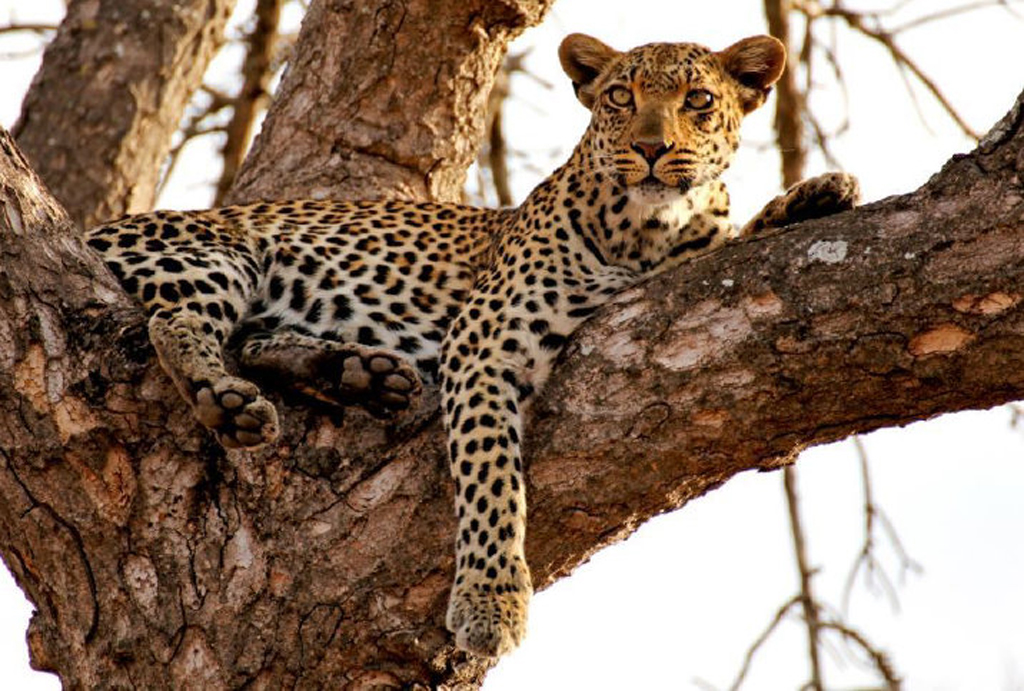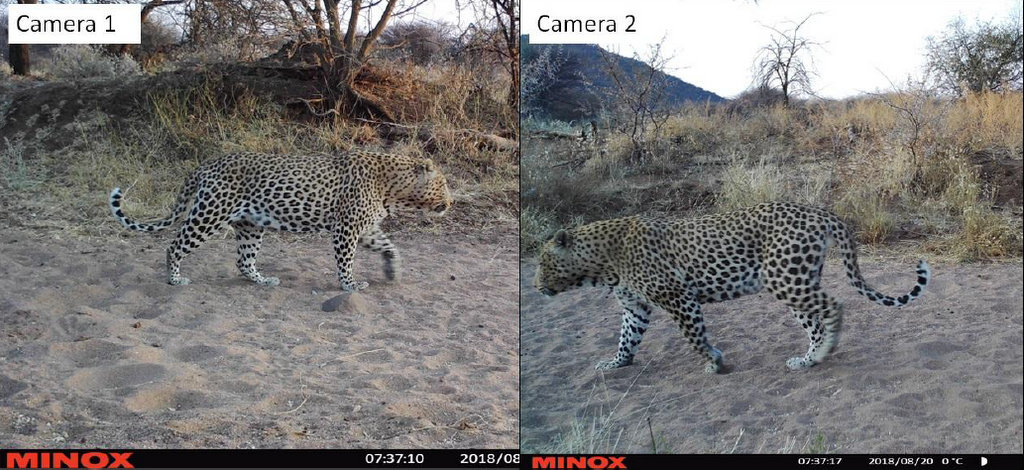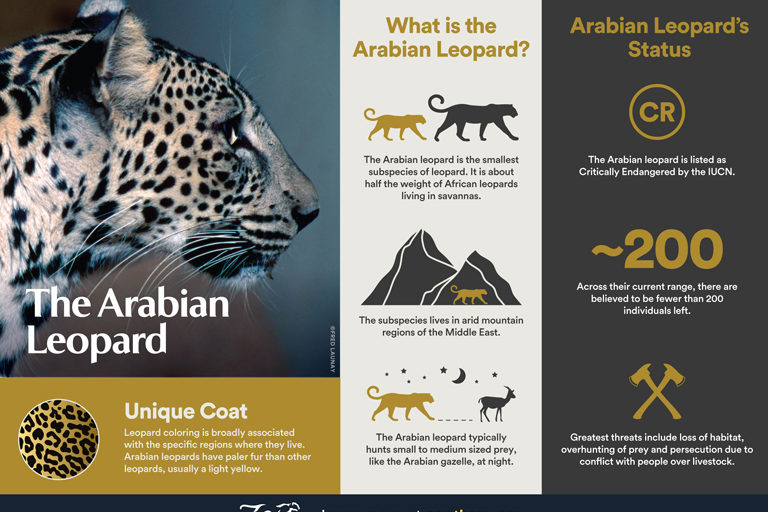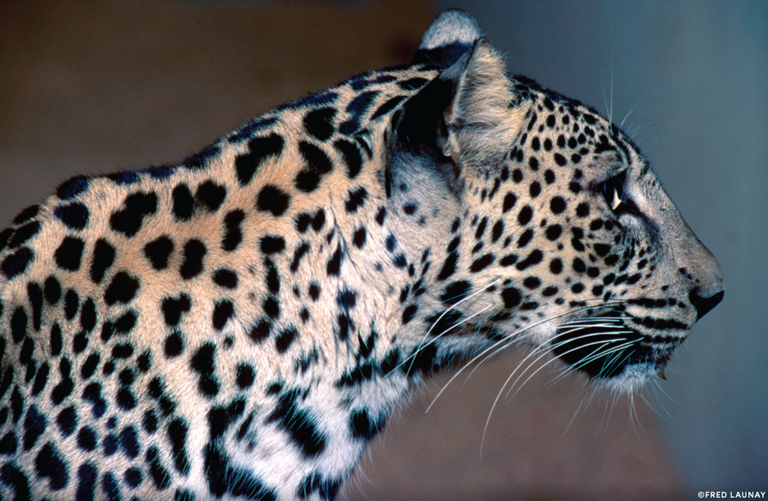Leopard
- Lisbeth
- Site Admin
- Posts: 67457
- Joined: Sat May 19, 2012 12:31 pm
- Country: Switzerland
- Location: Lugano
- Contact:
Re: Leopard
The "golden" one  (I prefer the normal ones, but something different does not hurt
(I prefer the normal ones, but something different does not hurt  )
)
"Education is the most powerful weapon which you can use to change the world." Nelson Mandela
The desire for equality must never exceed the demands of knowledge
The desire for equality must never exceed the demands of knowledge
- Mel
- Global Moderator
- Posts: 28239
- Joined: Sat May 19, 2012 12:31 pm
- Country: Germany
- Location: Föhr
- Contact:
Re: Leopard
Now I can see the difference too 
God put me on earth to accomplish a certain amount of things. Right now I'm so far behind that I'll never die.
- Richprins
- Committee Member
- Posts: 76020
- Joined: Sat May 19, 2012 3:52 pm
- Location: NELSPRUIT
- Contact:
Re: Leopard
Rare vocalisation! 


Please check Needs Attention pre-booking: https://africawild-forum.com/viewtopic.php?f=322&t=596
- Lisbeth
- Site Admin
- Posts: 67457
- Joined: Sat May 19, 2012 12:31 pm
- Country: Switzerland
- Location: Lugano
- Contact:
Re: Leopard
MEOW! on a high note 
"Education is the most powerful weapon which you can use to change the world." Nelson Mandela
The desire for equality must never exceed the demands of knowledge
The desire for equality must never exceed the demands of knowledge
- Mel
- Global Moderator
- Posts: 28239
- Joined: Sat May 19, 2012 12:31 pm
- Country: Germany
- Location: Föhr
- Contact:
Re: Leopard
God put me on earth to accomplish a certain amount of things. Right now I'm so far behind that I'll never die.
- Lisbeth
- Site Admin
- Posts: 67457
- Joined: Sat May 19, 2012 12:31 pm
- Country: Switzerland
- Location: Lugano
- Contact:
Re: Leopard
Leopards in Namibia – latest population census results
Posted on September 2, 2019 by Africa Geographic Editorial in the NEWS DESK post series.

NEWS DESK POST by AG Editorial
The latest census (August 2019) of Namibia’s leopards estimates a population of 11,733 leopards. This is a reduction from the 14,154 estimate from a 2011 census (Stein et al). The report states that the leopard population is not declining country-wide, and that changes in methodology caused the drop in reported populations between 2011 and 2019.
Information and data for the census was collected from across Namibia, including sightings, photographs, distribution data and population trends. Two camera trap surveys and an intensive questionnaire survey were also conducted. Some areas showed leopard density increases over the 2011 census, and others showed reductions.

Camera trap footage of two leopards © National Leopard Census Project / LRC Wildlife Conservation
Evidence collected reveals that the core of Namibia’s leopard population occurs on freehold farmland and communal conservancies in the Kunene region, where they are under pressure due to human-leopard conflict and illegal poaching using wire snares. Populations in these areas are higher than they are in national parks because of less competition from other predators and a higher prey base.
Results show a clear link between the tolerance of leopards on the one hand, and income-generating activities (photographic tourism and trophy hunting) on the other hand. The report suggests that the biggest threat to leopard populations in Namibia is ‘problem leopard’ removal due to human-leopard conflict.
The research was led by carnivore specialist Dr Louisa Richmond-Coggan of LRC Wildlife Conservation. Her website description of this project: “In cooperation with the Ministry of Environment and Tourism, NAPHA has employed my services to undertake a Leopard: National Censusing & Sustainable Hunting Practices study which will run from June 2017 to December 2018.”
The following organisations collaborated to carry out this census:
• The Namibian Ministry of Environment & Tourism (MET);
• The Large Carnivore Management Association of Namibia (LCMAN);
• The Namibian Professional Hunting Association (NAPHA);
• The Namibian Chamber of Commerce (NCE).
Posted on September 2, 2019 by Africa Geographic Editorial in the NEWS DESK post series.

NEWS DESK POST by AG Editorial
The latest census (August 2019) of Namibia’s leopards estimates a population of 11,733 leopards. This is a reduction from the 14,154 estimate from a 2011 census (Stein et al). The report states that the leopard population is not declining country-wide, and that changes in methodology caused the drop in reported populations between 2011 and 2019.
Information and data for the census was collected from across Namibia, including sightings, photographs, distribution data and population trends. Two camera trap surveys and an intensive questionnaire survey were also conducted. Some areas showed leopard density increases over the 2011 census, and others showed reductions.

Camera trap footage of two leopards © National Leopard Census Project / LRC Wildlife Conservation
Evidence collected reveals that the core of Namibia’s leopard population occurs on freehold farmland and communal conservancies in the Kunene region, where they are under pressure due to human-leopard conflict and illegal poaching using wire snares. Populations in these areas are higher than they are in national parks because of less competition from other predators and a higher prey base.
Results show a clear link between the tolerance of leopards on the one hand, and income-generating activities (photographic tourism and trophy hunting) on the other hand. The report suggests that the biggest threat to leopard populations in Namibia is ‘problem leopard’ removal due to human-leopard conflict.
The research was led by carnivore specialist Dr Louisa Richmond-Coggan of LRC Wildlife Conservation. Her website description of this project: “In cooperation with the Ministry of Environment and Tourism, NAPHA has employed my services to undertake a Leopard: National Censusing & Sustainable Hunting Practices study which will run from June 2017 to December 2018.”
The following organisations collaborated to carry out this census:
• The Namibian Ministry of Environment & Tourism (MET);
• The Large Carnivore Management Association of Namibia (LCMAN);
• The Namibian Professional Hunting Association (NAPHA);
• The Namibian Chamber of Commerce (NCE).
"Education is the most powerful weapon which you can use to change the world." Nelson Mandela
The desire for equality must never exceed the demands of knowledge
The desire for equality must never exceed the demands of knowledge
- Lisbeth
- Site Admin
- Posts: 67457
- Joined: Sat May 19, 2012 12:31 pm
- Country: Switzerland
- Location: Lugano
- Contact:
Re: Leopard
A lifeline for the last leopards (commentary)
Commentary by Thomas S. Kaplan on 10 September 2019
- From being extinct in the wild, the Arabian oryx was reclassified in 1986 as “Endangered” on the International Union for Conservation of Nature (IUCN) Red List of Threatened Species after its reintroduction to Oman, Saudi Arabia, Jordan, Syria, and the United Arab Emirates. In 2011, with its global numbers increased to thousands, the Arabian oryx was the first animal ever to revert to “Vulnerable” status after having previously been listed as extinct in the wild.
- Today, the Kingdom of Saudi Arabia’s Royal Commission for AlUla (RCU) aims to replicate this miraculous turnaround for the Arabian leopard – a little-studied, desert-dwelling subspecies listed as “Critically Endangered” on the IUCN’s Red List – and for leopard populations everywhere with a new $20 million commitment to the Global Alliance for Wild Cats.
- The Arabian Leopard Initiatives will support a holistic and urgent program to rigorously monitor the Arabian leopard’s population and distribution, as well as halt its decline through community conservation projects. The cornerstone will be a captive breeding program dedicated to shoring up Arabian leopard populations and reintroducing them into their former habitats.
- This post is a commentary. The views expressed are those of the author, not necessarily Mongabay.
The Arabian Peninsula is home to one of the greatest — yet mostly unrecognized — species resurrection stories in recent times: the Arabian oryx.
Left for dead after it disappeared from the wild in the 1970s, this iconic species, characterized by its long straight horns, was saved from extinction by a visionary captive-breeding and reintroduction program inspired by the late founder of the United Arab Emirates, Sheikh Zayed bin Sultan Al Nahyan. This effort constituted an unparalleled conservation success that is now regarded as a case study in how to do things “right” in order to save a species.
From being extinct in the wild, the Arabian oryx was reclassified in 1986 as “Endangered” on the International Union for Conservation of Nature (IUCN) Red List of Threatened Species after its reintroduction to Oman, Saudi Arabia, Jordan, Syria, and the United Arab Emirates. In 2011, with its global numbers increased to thousands, the Arabian oryx was the first animal ever to revert to “Vulnerable” status after having previously been listed as extinct in the wild.
Today, the Kingdom of Saudi Arabia’s Royal Commission for AlUla (RCU) aims to replicate this miraculous turnaround for the Arabian leopard — a little-studied, desert-dwelling subspecies listed as “Critically Endangered” on the IUCN’s Red List — and for leopard populations everywhere with a new $20 million commitment to the Global Alliance for Wild Cats. Fewer than 200 Arabian leopards roam often-isolated patches of Oman, Yemen, and Saudi Arabia; the leopard stands as the most persecuted big cat in the world, and its potential loss would be catastrophic for the world’s biological and cultural heritage.
But RCU has announced a series of consequential initiatives to bring their country’s big cats back from the brink. In the shadow of the recently released (and devastating) United Nations report on biodiversity, which found that one million animal and plant species are at risk of extinction, the new Arabian Leopard Initiatives (ALI) represent a much-needed source of hope, worthy of the world’s attention and support.

Despite the ubiquity of leopard spots in fashion, leopards lack the critical mass of champions that characterizes other threatened species such as lions, tigers, rhinos, or elephants. The reality is simply that without advocates who genuinely care, the world’s most charismatic species are at the most risk. While popular culture is putting big cats in the spotlight (as in the case of Netflix’s “Our Planet,” which captured for the first time Arabian leopards meeting and mating, or the new remake of The Lion King), world leaders must also step up.
Now the Arabian leopard’s champions have emerged. Led by its Governor, HH Prince Badr bin Abdullah Al-Saud, and Chief Executive Amr AlMadani, RCU’s experiment in biological and cultural conservation is centered on a comprehensive and innovative ecotourism project located in the Kingdom’s northwest, home to towering sandstone mountains and Saudi Arabia’s first UNESCO World Heritage Site.
The Commission has established the Al Sharaan Nature Reserve, which promises to become irresistible to both nature lovers and those curious about the region’s prodigious cultural and archeological footprint. With reintroduction of the Nubian ibex, red-necked ostrich, and Arabian gazelles underway, the project is already proving its mettle as one of the world’s most ambitious landscape rehabilitation ventures. The Reserve delivers that “golden ticket” required for apex predators to flourish — namely, plenty of land in which to roam and prey to consume. But RCU will have the most global reverberations, in fact, in the launch of the Arabian Leopard Initiatives.
At the heart of ALI lies a fund whose endowment at last will ensure a sustainable future for the Arabian leopard – one in which it is easy to imagine the cat thriving across the Arabian Peninsula and beyond, as a new symbol for regional prosperity and cooperation. The fund will support a holistic and urgent program to rigorously monitor the Arabian leopard’s population and distribution, as well as halt its decline through community conservation projects. The cornerstone will be a captive breeding program dedicated to shoring up Arabian leopard populations and reintroducing them into their former habitats. Panthera, the global wild cat conservation organization of which I am Chairman and co-founder, will be using the very best practices in both environmental and community engagement, jointly with The Royal Commission for AlUla, in implementing their strategies.
Just weeks after the official launch of ALI, the captive breeding program has already borne precious fruit with the births of twin male and female Arabian leopard cubs to mother Hamms. A timely source of inspiration and momentum, these cubs are also a reminder that when scientific ingenuity meets a fierce commitment to transformative conservation, a brighter future for the species — out of reach for many decades — suddenly appears within sight.
ALI seeks to shake us all out of our longstanding apathy, loudly proclaiming that species conservation is not only possible, but paramount to our collective environmental, economic, and cultural health. It not only aims to save this particular subspecies, but also create a new model combining scientific research, cultural preservation, landscape-wide ecological restoration, and ecotourism. It is my hope that others will follow in the Commission’s bold footsteps and make the investments necessary to save the rest of the world’s critical ecosystems, and the threatened species that live within them.
Some 50 years ago, conservationists and Arab leaders faced a clear choice: let the Arabian oryx “go gentle into that good night,” to invoke Welsh poet Dylan Thomas, or mobilize with the abandon required to save a species. With the Arabian leopard, in our time, let us once again prove that “hopeless” is but a mindset.

An Arabian Leopard in Saudi Arabia. Photo Credit: Fred Launay.
Dr. Thomas S. Kaplan is Chairman and Co-Founder of Panthera.
Commentary by Thomas S. Kaplan on 10 September 2019
- From being extinct in the wild, the Arabian oryx was reclassified in 1986 as “Endangered” on the International Union for Conservation of Nature (IUCN) Red List of Threatened Species after its reintroduction to Oman, Saudi Arabia, Jordan, Syria, and the United Arab Emirates. In 2011, with its global numbers increased to thousands, the Arabian oryx was the first animal ever to revert to “Vulnerable” status after having previously been listed as extinct in the wild.
- Today, the Kingdom of Saudi Arabia’s Royal Commission for AlUla (RCU) aims to replicate this miraculous turnaround for the Arabian leopard – a little-studied, desert-dwelling subspecies listed as “Critically Endangered” on the IUCN’s Red List – and for leopard populations everywhere with a new $20 million commitment to the Global Alliance for Wild Cats.
- The Arabian Leopard Initiatives will support a holistic and urgent program to rigorously monitor the Arabian leopard’s population and distribution, as well as halt its decline through community conservation projects. The cornerstone will be a captive breeding program dedicated to shoring up Arabian leopard populations and reintroducing them into their former habitats.
- This post is a commentary. The views expressed are those of the author, not necessarily Mongabay.
The Arabian Peninsula is home to one of the greatest — yet mostly unrecognized — species resurrection stories in recent times: the Arabian oryx.
Left for dead after it disappeared from the wild in the 1970s, this iconic species, characterized by its long straight horns, was saved from extinction by a visionary captive-breeding and reintroduction program inspired by the late founder of the United Arab Emirates, Sheikh Zayed bin Sultan Al Nahyan. This effort constituted an unparalleled conservation success that is now regarded as a case study in how to do things “right” in order to save a species.
From being extinct in the wild, the Arabian oryx was reclassified in 1986 as “Endangered” on the International Union for Conservation of Nature (IUCN) Red List of Threatened Species after its reintroduction to Oman, Saudi Arabia, Jordan, Syria, and the United Arab Emirates. In 2011, with its global numbers increased to thousands, the Arabian oryx was the first animal ever to revert to “Vulnerable” status after having previously been listed as extinct in the wild.
Today, the Kingdom of Saudi Arabia’s Royal Commission for AlUla (RCU) aims to replicate this miraculous turnaround for the Arabian leopard — a little-studied, desert-dwelling subspecies listed as “Critically Endangered” on the IUCN’s Red List — and for leopard populations everywhere with a new $20 million commitment to the Global Alliance for Wild Cats. Fewer than 200 Arabian leopards roam often-isolated patches of Oman, Yemen, and Saudi Arabia; the leopard stands as the most persecuted big cat in the world, and its potential loss would be catastrophic for the world’s biological and cultural heritage.
But RCU has announced a series of consequential initiatives to bring their country’s big cats back from the brink. In the shadow of the recently released (and devastating) United Nations report on biodiversity, which found that one million animal and plant species are at risk of extinction, the new Arabian Leopard Initiatives (ALI) represent a much-needed source of hope, worthy of the world’s attention and support.

Despite the ubiquity of leopard spots in fashion, leopards lack the critical mass of champions that characterizes other threatened species such as lions, tigers, rhinos, or elephants. The reality is simply that without advocates who genuinely care, the world’s most charismatic species are at the most risk. While popular culture is putting big cats in the spotlight (as in the case of Netflix’s “Our Planet,” which captured for the first time Arabian leopards meeting and mating, or the new remake of The Lion King), world leaders must also step up.
Now the Arabian leopard’s champions have emerged. Led by its Governor, HH Prince Badr bin Abdullah Al-Saud, and Chief Executive Amr AlMadani, RCU’s experiment in biological and cultural conservation is centered on a comprehensive and innovative ecotourism project located in the Kingdom’s northwest, home to towering sandstone mountains and Saudi Arabia’s first UNESCO World Heritage Site.
The Commission has established the Al Sharaan Nature Reserve, which promises to become irresistible to both nature lovers and those curious about the region’s prodigious cultural and archeological footprint. With reintroduction of the Nubian ibex, red-necked ostrich, and Arabian gazelles underway, the project is already proving its mettle as one of the world’s most ambitious landscape rehabilitation ventures. The Reserve delivers that “golden ticket” required for apex predators to flourish — namely, plenty of land in which to roam and prey to consume. But RCU will have the most global reverberations, in fact, in the launch of the Arabian Leopard Initiatives.
At the heart of ALI lies a fund whose endowment at last will ensure a sustainable future for the Arabian leopard – one in which it is easy to imagine the cat thriving across the Arabian Peninsula and beyond, as a new symbol for regional prosperity and cooperation. The fund will support a holistic and urgent program to rigorously monitor the Arabian leopard’s population and distribution, as well as halt its decline through community conservation projects. The cornerstone will be a captive breeding program dedicated to shoring up Arabian leopard populations and reintroducing them into their former habitats. Panthera, the global wild cat conservation organization of which I am Chairman and co-founder, will be using the very best practices in both environmental and community engagement, jointly with The Royal Commission for AlUla, in implementing their strategies.
Just weeks after the official launch of ALI, the captive breeding program has already borne precious fruit with the births of twin male and female Arabian leopard cubs to mother Hamms. A timely source of inspiration and momentum, these cubs are also a reminder that when scientific ingenuity meets a fierce commitment to transformative conservation, a brighter future for the species — out of reach for many decades — suddenly appears within sight.
ALI seeks to shake us all out of our longstanding apathy, loudly proclaiming that species conservation is not only possible, but paramount to our collective environmental, economic, and cultural health. It not only aims to save this particular subspecies, but also create a new model combining scientific research, cultural preservation, landscape-wide ecological restoration, and ecotourism. It is my hope that others will follow in the Commission’s bold footsteps and make the investments necessary to save the rest of the world’s critical ecosystems, and the threatened species that live within them.
Some 50 years ago, conservationists and Arab leaders faced a clear choice: let the Arabian oryx “go gentle into that good night,” to invoke Welsh poet Dylan Thomas, or mobilize with the abandon required to save a species. With the Arabian leopard, in our time, let us once again prove that “hopeless” is but a mindset.

An Arabian Leopard in Saudi Arabia. Photo Credit: Fred Launay.
Dr. Thomas S. Kaplan is Chairman and Co-Founder of Panthera.
"Education is the most powerful weapon which you can use to change the world." Nelson Mandela
The desire for equality must never exceed the demands of knowledge
The desire for equality must never exceed the demands of knowledge
- Lisbeth
- Site Admin
- Posts: 67457
- Joined: Sat May 19, 2012 12:31 pm
- Country: Switzerland
- Location: Lugano
- Contact:
Re: Leopard
Leopard takes down Impala
A ROLLER COASTER
OF EMOTIONS AS
EPIC HUNT UNFOLDS

by
Kevin Dooley
Friday, 13 September 2019

The unpredictable nature of wildlife is what makes going on safari special and unique. Who knows what may be lurking around the next acacia bush or down a quiet dry riverbed? However, knowing what signs to watch for and adopting a deeper understanding of animal behaviour can give you that little boost in ‘reading’ this unpredictability. Being patient and knowing when to hang back and concentrate on one animal, rather than hurrying off to the next sighting, may be rewarded with an unbelievably epic sighting. And if you are lucky enough to bear witness to any sighting of such magnitude, then it is sure to remain in your memories for a long time to come.
And this is clearly what happened to professional wildlife photographer Kevin Dooley ..........................
If you want to read the thrilling story and see the spectacular photos, click on the tittle
A ROLLER COASTER
OF EMOTIONS AS
EPIC HUNT UNFOLDS

by
Kevin Dooley
Friday, 13 September 2019

The unpredictable nature of wildlife is what makes going on safari special and unique. Who knows what may be lurking around the next acacia bush or down a quiet dry riverbed? However, knowing what signs to watch for and adopting a deeper understanding of animal behaviour can give you that little boost in ‘reading’ this unpredictability. Being patient and knowing when to hang back and concentrate on one animal, rather than hurrying off to the next sighting, may be rewarded with an unbelievably epic sighting. And if you are lucky enough to bear witness to any sighting of such magnitude, then it is sure to remain in your memories for a long time to come.
And this is clearly what happened to professional wildlife photographer Kevin Dooley ..........................
If you want to read the thrilling story and see the spectacular photos, click on the tittle
"Education is the most powerful weapon which you can use to change the world." Nelson Mandela
The desire for equality must never exceed the demands of knowledge
The desire for equality must never exceed the demands of knowledge
- Peter Betts
- Posts: 3084
- Joined: Fri Jun 01, 2012 9:28 am
- Country: RSA
- Contact:


